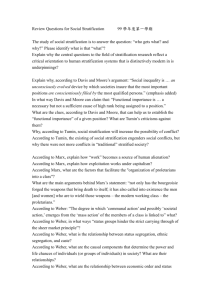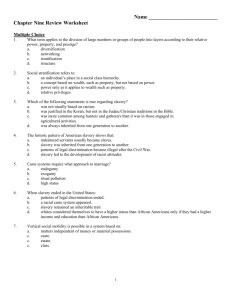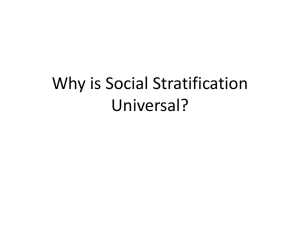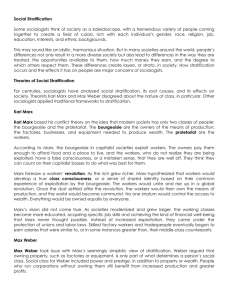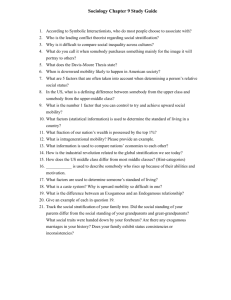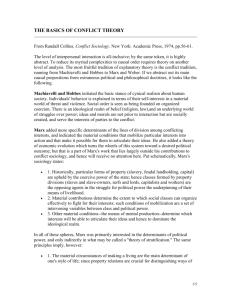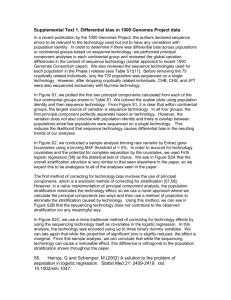henslin7
advertisement
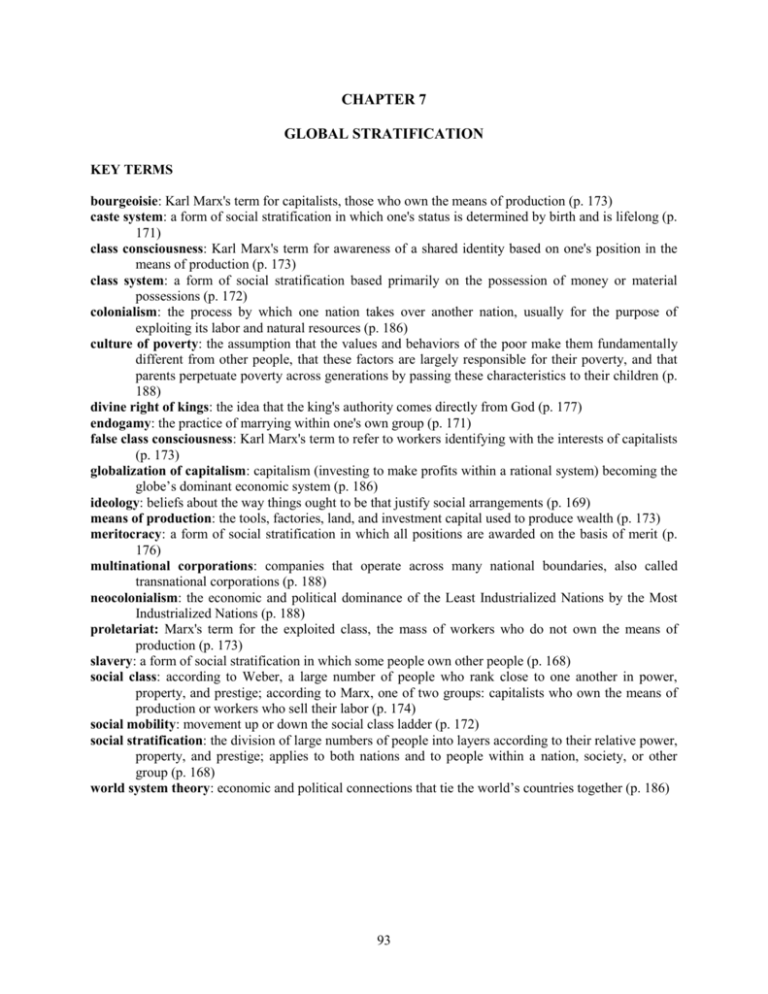
CHAPTER 7 GLOBAL STRATIFICATION KEY TERMS bourgeoisie: Karl Marx's term for capitalists, those who own the means of production (p. 173) caste system: a form of social stratification in which one's status is determined by birth and is lifelong (p. 171) class consciousness: Karl Marx's term for awareness of a shared identity based on one's position in the means of production (p. 173) class system: a form of social stratification based primarily on the possession of money or material possessions (p. 172) colonialism: the process by which one nation takes over another nation, usually for the purpose of exploiting its labor and natural resources (p. 186) culture of poverty: the assumption that the values and behaviors of the poor make them fundamentally different from other people, that these factors are largely responsible for their poverty, and that parents perpetuate poverty across generations by passing these characteristics to their children (p. 188) divine right of kings: the idea that the king's authority comes directly from God (p. 177) endogamy: the practice of marrying within one's own group (p. 171) false class consciousness: Karl Marx's term to refer to workers identifying with the interests of capitalists (p. 173) globalization of capitalism: capitalism (investing to make profits within a rational system) becoming the globe’s dominant economic system (p. 186) ideology: beliefs about the way things ought to be that justify social arrangements (p. 169) means of production: the tools, factories, land, and investment capital used to produce wealth (p. 173) meritocracy: a form of social stratification in which all positions are awarded on the basis of merit (p. 176) multinational corporations: companies that operate across many national boundaries, also called transnational corporations (p. 188) neocolonialism: the economic and political dominance of the Least Industrialized Nations by the Most Industrialized Nations (p. 188) proletariat: Marx's term for the exploited class, the mass of workers who do not own the means of production (p. 173) slavery: a form of social stratification in which some people own other people (p. 168) social class: according to Weber, a large number of people who rank close to one another in power, property, and prestige; according to Marx, one of two groups: capitalists who own the means of production or workers who sell their labor (p. 174) social mobility: movement up or down the social class ladder (p. 172) social stratification: the division of large numbers of people into layers according to their relative power, property, and prestige; applies to both nations and to people within a nation, society, or other group (p. 168) world system theory: economic and political connections that tie the world’s countries together (p. 186) 93 KEY PEOPLE Randall Collins: Collins is a contemporary conflict theorist who has broadened conflict theory to include analysis of competition between groups within the same class for scarce resources. Kingsley Davis and Wilbert Moore: These functionalists developed the theory of stratification that suggests inequality is universal because it helps societies survive by motivating the most qualified members of society to strive to fill the most important social positions. John Kenneth Galbraith: This economist argued that the Least Industrialized Nations remain poor because their own culture holds them back. Michael Harrington: Harrington saw that colonialism had been replaced by neocolonialism. Martha Huggins: Huggins has studied poverty in the Least Industrialized Nations. Gehard Lenski: Lenski offered a synthesis of the functionalist and conflict views of stratification. Gerda Lerner: This historian has noted that women were the first people who were enslaved as a result of war and conquest. Oscar Lewis: Lewis is the anthropologist who first suggested the reason some people are poor is because they live in a culture of poverty. Karl Marx: Marx concluded that social class depended exclusively on the means of production; an individual’s social class depended on whether or not he owned the means of production. Gaetano Mosca: Mosca argued that every society is inevitably stratified by power. James Schellenberg: Schellenberg is a contemporary conflict theorist. Melvin Tumin: Tumin was the first to offer a criticism of the functionalist view on stratification. Immanuel Wallerstein: Wallerstein proposed a world system theory to explain global stratification. Max Weber: Weber argued that social class was based on three components—class, status, and power. 94 Chapter 7 Global Stratification PRACTICE TEST 1. Social stratification refers to: a. an individual’s place in a social class hierarchy. b. a concept based on wealth, such as property, but not based on power. c. power only as it applies to wealth such as property. d. relative privileges. 2. Ownership of some people by others defines the ______________ system. a. caste b. estate c. slavery d. class 3. Of the following, which variable was not one on which slavery was initially based on? a. debt b. crime c. war d. race 4. In the caste system, position in the stratification hierarchy is based on: a. achieved status. c. racial purity. b. ascribed status. d. level of education. 5. It is cultural tradition that members of the Jaconi tribe marry only other Jaconi who share a similar position on the stratification level. The Jaconi have established the practice of: a. endogamy. b. exogamy. c. heterogamy. d. monogamy. 6. According to Marx, those who own the means of production are the: a. bourgeoisie. c. lumpenproletariat. b. proletariat. d. petty bourgeoisie. 7. According to Karl Marx, social class depends on a single factor, the: a. means of production. c. race or ethnicity of the individual. b. degree of consumption. d. amount of land they own. 8. The mistaken notion held by workers that they themselves are capitalists and will someday share in the wealth of society is what Marx referred to as: a. class consciousness. c. group polarization. b. social disorganization. d. false class consciousness. 9. Marx referred to the tools, factories, land, and investment capital used to produce wealth as: a. the means of production. c. class consciousness. b. the mode of production. d. the lumpenproletariat. 10. The outspoken critic of Karl Marx who said class was based on property, prestige, and power was: a. Max Weber . c. Kingsley Davis. b. Gaetano Mosca. d. Wilbert Moore. 11. The sociological perspective that stresses society’s positions must be filled by the most qualified people is the: a. symbolic interactionist view. c. the conflict view. b. functionalist view. d. neo-conflict view. 95 12. Which of the following is NOT one of the components of social class as presented by Max Weber? a. property c. power b. prestige d. personality 13. Davis and Moore argued that stratification is inevitable because: a. some positions are more important than others. b. the more important positions must be filled by the more qualified people. c. to motivate the more qualified people to fill these positions, society must offer them greater rewards. d. all of the above are true. 14. Gerhard Lenski based his explanation on whether or not a society is held together by the principles of functionalism or conflict is based primarily on their: a. degree of ethnic purity. c. economic system. b. degree of surplus. d. level of technological advancement. 15. The idea that the king’s authority comes directly from God is known as: a. Racial right. b. class privilege. c. blue blood. d. divine right of kings. 16. The method of stratification that involves the process of one nation taking over another by military force, popular in the nineteenth century, was called: a. dependency theory. c. world systems theory. b. colonialism. d. multinationalism theory. 17. World Systems Theory was developed by ________________ to explain how global stratification came about. a. Karl Marx c. Melvin Tumin b. Max Weber d. Immanuel Wallerstein 18. The concept that some nations are crippled by a way of life that perpetuates a culture of poverty is an argument presented by economist: a. John Kenneth Galbraith. c. Melvin Tumin. b. Immanuel Wallerstein. d. Gerhard Lenski. 19. The classification Most Industrialized Nations includes: a. Canada, Brazil, and the United States. b. the United States, Switzerland, and South Africa. c. France, Germany, and Australia. d. Japan, Kuwait, and the United States. 20. The classification of nations that have the highest percentage of the world’s population and earth’s land mass is the: a. Most Industrialized Nations. c. Least Industrialized Nations. b. The First World Nations. d. Second World Nations. 21. One significant characteristic of the Least Industrialized Nations is the fact that; a. they occupy three-fourths of the land’s surface. b. they represent over two-thirds of the world’s population. c. most residents now have access to trained physicians. d. these countries have a low percentage of the overall growth rate of the world population. 96 Chapter 7 Global Stratification 22. Immanuel Wallerstein’s theory on world system notes that: a. periphery nations develop more than core nations. b. Germany was the first to become a core nation. c. most African countries are fringe nations. d. Britain, Holland, and France are core nations. 23. The difference between colonialism and neocolonialism is primarily that in neocolonialism: a. the military influence of the dominating country is less obvious. b. the dominating country improves the standard of living across the board in the developing country. c. classes within the developing nation shrink. d. democracy is established as well as capitalism. 24. Multinational corporations: a. are companies that operate across many national boundaries. b. help to maintain the global dominance of the Most Industrial Nations. c. are based predominantly in the Least Industrialized Nations. d. both a and b are correct. 25. The “Asian Tigers” refers to: a. a talented baseball team that has developed in Taiwan after it embraced capitalism. b. the dominant Chinese influence that has threatened capitalism in weaker nations. c. Pacific Rim nations with advanced capitalism that challenge older capitalist nations. d. Asian nations with vast economies based on the military industrial complex. 97 PRACTICE TEST — ANSWER KEY 1. D (page 168) 2. C (page 168) 3. D (page 168) 4. B (page 171) 5. A (page 171) 6. A (page 173) 7. A (page 173) 8. D (page 173) 9. A (page 173) 10. A (page 174) 11. B (page 175) 12. D (page 174) 13. D (page 175) 14. D (page 177) 15. D (page 177) 16. B (page 186) 17. D (page 186) 18. A (page 188) 98 19. C (page 189) 20. C (page 189) 21. B (page 189) 22. D (page 186) 23. A (page 186) 24. D (page 189) 25. C (page 189)
